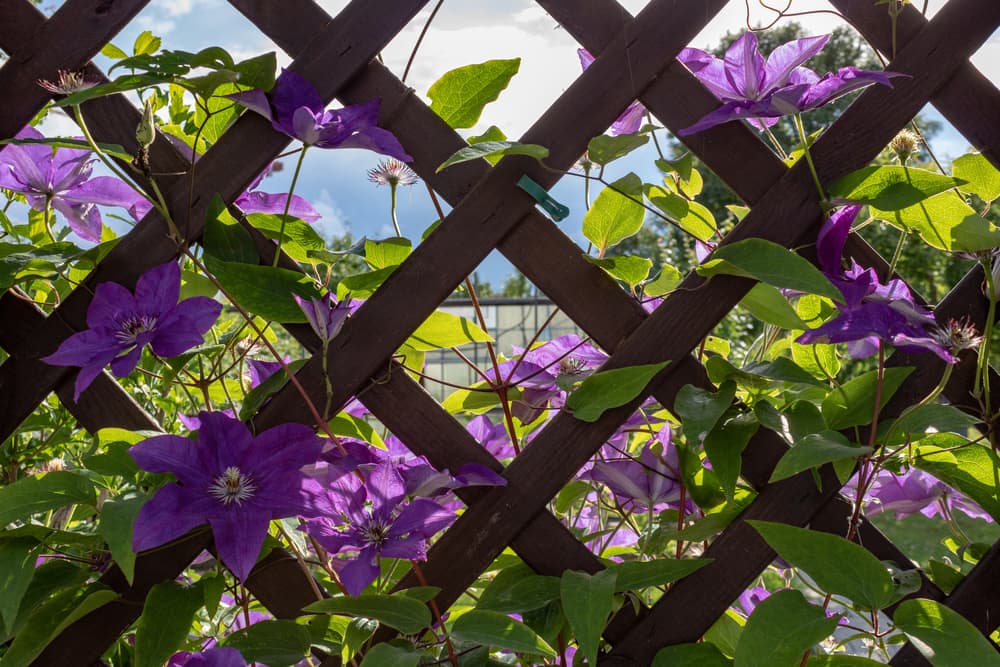Train Your Clematis To Climb: Experts Share Their Advice For Trellis, Walls And Fences

CLIMBERS > CLEMATIS > TRAINING
Chris is a gardening writer and nature enthusiast. He graduated from Oxford Brookes University in 2022 with an MA in Psychology. Chris works with the Leeds Green Action Society, helping their food cooperative by growing various fruit and vegetables on their two allotments in Hyde Park, Leeds.
Reviewed By COLIN SKELLY

Colin is a Horticulturist and Horticultural Consultant with experience in a range of practical and managerial roles across heritage, commercial and public horticulture. He holds the Royal Horticultural Society’s Master of Horticulture award and has a particular interest in horticultural ecology and naturalistic planting for habitat and climate resilience.
Contributions From FRASER WESCOTT

A clematis specialist based in Wiltshire, Fraser has 27 years of horticultural experience. His nursery is a recognised seller of clematis by the RHS and he has a large following on Facebook, where the nursery shares regular updates.

Ken is the Membership Secretary of the British Clematis Society and a member of the International Clematis Society, RHS Silver-Medalist, Owner of Ken Black Clematis and star of his own YouTube channel, where he shares knowledge learned over the course of 40 years.

Peter is the third-generation Owner of specialist nursery Thorncroft Clematis who are 12 x RHS Chelsea Gold Medal winners and known worldwide for their expertise and knowledge in the field of clematis. Peter is also a sought-after public speaker on the topic of clematis and is a guest speaker for The English Garden School at Chelsea Physic Garden in London.

Fiona is the Secretary of the International Clematis Society and a member of the British Clematis Society. She has been growing Clematis for 40 years and even has a Clematis named in her honour!
IN THIS GUIDE
CLEMATIS GUIDES
Clematis sports a dainty and attractive bloom ranging from gentle violets to bold purples, to delicate whites and everything in between.
For the discerning gardener looking for an enticing but not overpowering splash of colour, this flower is a fantastic choice.
This versatile plant can be grown in the ground or in containers. In the latter, they make great ornamental flowers that will remain at a fairly manageable size.
Grown in the ground, however, and clematis will grow to a much bigger size.
It will also climb: a property that many gardeners put to great effect by training the plant to climb trees, fences, trellises, and all sorts of vertical surfaces.

“If you get the planting and the position right, then the plant should establish well and find the support that you have provided,” shares Colin Skelly, a Master Horticulturist.
“I find Clematis to be generally self-training and I only usually need to remove the occasional stem that has gone awry.
“It depends to some extent on the space available and the style of garden that you have.
“Larger and more naturalistic gardens suit Clematis that fills a space more naturally whilst smaller, more formal gardens will suit a more tended, tied-in approach.”
Training Your Clematis To Climb

We’ll begin with fences and trellises, before moving on to pillars.
Training On A Trellis

With a trellis, you enjoy the luxury of having spaces between the various bits of wood, which make tying your clematis much easier.
We definitely recommend this method if you’re not looking to use too many power tools!
The first step is to plant your clematis, and the roots should be about 6 inches from the base of the support structure.
“When a clematis is young, the stems aren’t as thick and robust, so need adequate support low down or they can be damaged,” says Fraser Wescott, owner of Walled Garden Nursery, a specialist clematis nursery.

While this may feel quite far away, it leaves space for the plant to grow, and it’s far preferable to planting too close to the wall and stifling growth!
Choose a type of clematis that suits the visual appeal you’re looking for and growing conditions in your garden.
All you need to do with your trellis is to tie branches onto the structure with twine, gardening wire, or a similar material.
“The wind is probably the biggest enemy of clematis, so ensuring that the growths are secured to prevent them from snapping is very important,” explains Ken Black, the owner of Ken Black Clematis, a specialist plant nursery.

However, it’s very important that you tie it on gently with plenty of room to move, because tight knots will restrict the growth of the branch and eventually kill it off!
“I use string to tie the clematis to a trellis so I can just cut the string when I prune the plant and put the whole lot in the green bin, rather than using plastic ties or wire which I would need to remove first,” says Fiona Woolfenden from the International Clematis Society.
“Using string saves me time later.
“I use a trellis with 4 inch (10 cm) holes which looks nice in the winter when the clematis have been pruned.
“Most of my clematis are late flowering varieties which are hard pruned every year, so I can also just weave in some of the stems in between the wood of the trellis when I am in a hurry.”

When the clematis reaches the right length, gently pull it upwards and attach a branch.
This will encourage future growth to continue upwards, and you can repeat the process by attaching ongoing growth further up the trellis as it becomes big enough.
Training On A Wall Or Fence

If you’re training your clematis directly up a wall or fence rather than up a support structure like a trellis, you need another way to keep it securely attached.
We recommend using lengths of wire arranged horizontally, running parallel to the ground at graduated heights proportionate to the eventual size of the plant.
Peter Skeggs-Gooch, the owner of the plant nursery Thorncroft Clematis & Climbers, opts for this method when supporting his own clematis:
“I suggest you use strong vine eyes and wire instead of trellis because it is less intrusive to the picture of the garden and, once the clematis is covering the wires, you won’t even see the support, making it look very natural.
“Furthermore, when built with good quality materials, this type of support requires little to no maintenance, meaning more time to enjoy the garden and your flowers!”
You’ll attach the clematis to these wires, and they’ll provide enough support to keep it growing well.

The steps are simple:
- Measure up from the ground to about a third of the eventual desired height of the plant.
- Make a mark on the fence or wall with a pen.
- Drill in here and insert a hook.
- Use a wire clip to attach your wire to the hook. Make sure to trim your wire to the desired length before starting.
- Run the wire horizontally to its length, and then make another mark at the end. Use a spirit level to check it’s straight if you don’t trust your eye.
- Drill another hole and use a turnbuckle to attach the wire.
- Tighten the wire so that it’s just about taut.
- Repeat the process for another wire about 12 inches above the first.
Training To Climb A Pillar
If you’ve got pillars supporting the corners of archways, verandas, or other garden structures, you can create a stunning visual effect by training climbing plants to grow up and around them.
We encourage experimenting with this idea as it’s a great way to liven up garden structures while giving your treasured plants more space to grow and thrive.

The process here doesn’t vary too much from growing up a trellis, except that the support structure is somewhat different.
“Make sure the first part of the support starts at least 12 inches from the ground,” says Fraser.
Here, we recommend using chicken wire cut to size and wrapped loosely around the pillar.
Simply wrap it around and use a couple of nails or hooks to keep the top section attached to prevent it from sliding down.

Once the chicken wire is in place, it’s just a case of tying your clematis branches onto it with twine, gardening wire, or similar (much like with the trellis!).
As the clematis grows you can encourage it to surround the pillar by tying it progressively further around.
Keeping Clematis In Check
While plenty of growth is very helpful when training your clematis to grow up or around a support structure, this plant can get a little unruly.
“In my view, clematis looks better when it is not growing above eye height,” says Ken Black.
“Therefore, if you want to grow up a wall, trellis or other structure, tie in the growths horizontally when the desired height has been reached.”
In addition to this, when the time rolls around to prune your clematis, we recommend doing so.
It may feel counterproductive to hinder growth, but you’ll find it much easier to coax the clematis into its desired shape if you have full control over the branches.

This plant boasts a number of varieties, and they fall into different pruning groups.
This means that instructions vary slightly for each, so make sure you know what you’re working with!
- For varieties in pruning group 1, prune in mid or late spring once they’ve flowered, and after the last frost. Pruning before the final frost will result in damaged new growth.
- For pruning group 2, prune a little earlier: February should do the trick. Then prune again lightly at the beginning of summer.
- For group 3, just prune in February.
Done right, climbing clematis is a real sight to behold.
These plants are striking and attractive, and their stems winding nimbly up a trellis, wall, pillar, or any other structure will bring a dash of colour and visual interest.

Incorporated into other floral displays, you’ll be surprised at how much of an impact a vertical element can bring to your garden – so much so that we bet you’ll come back for more!
